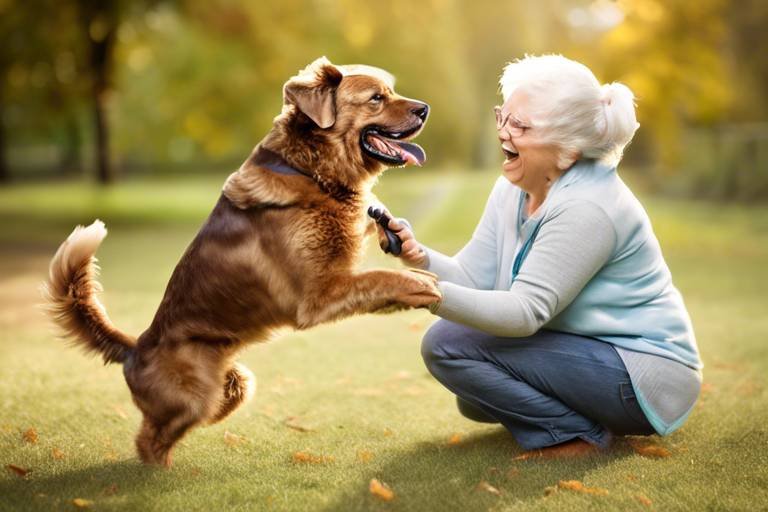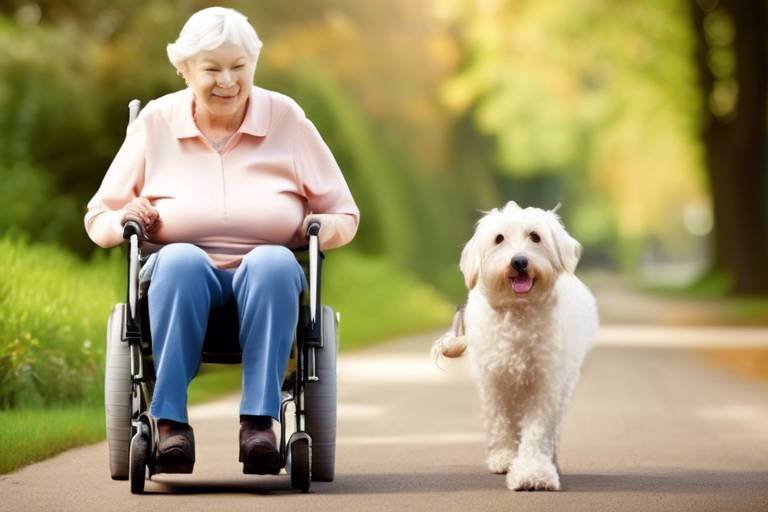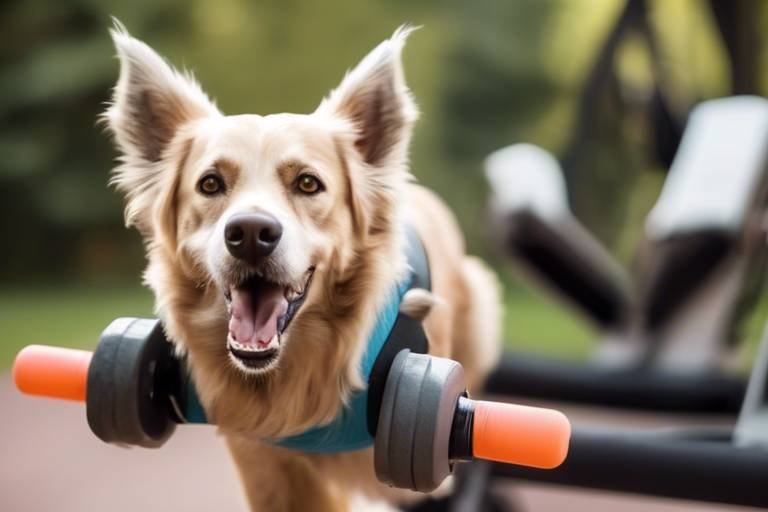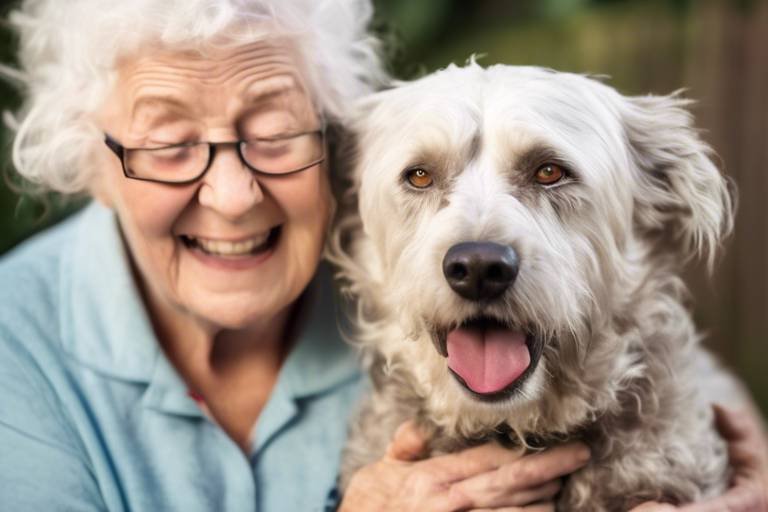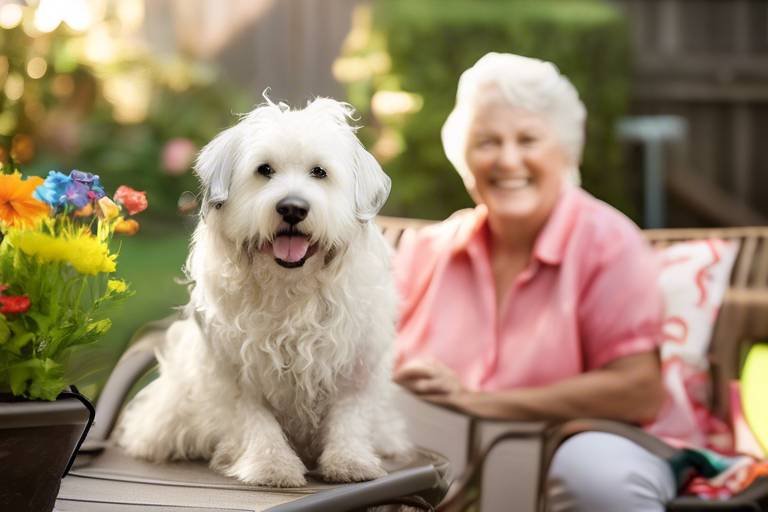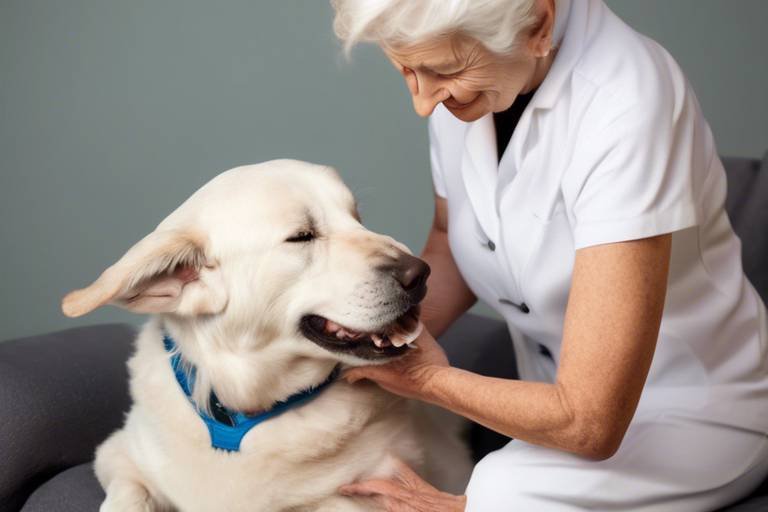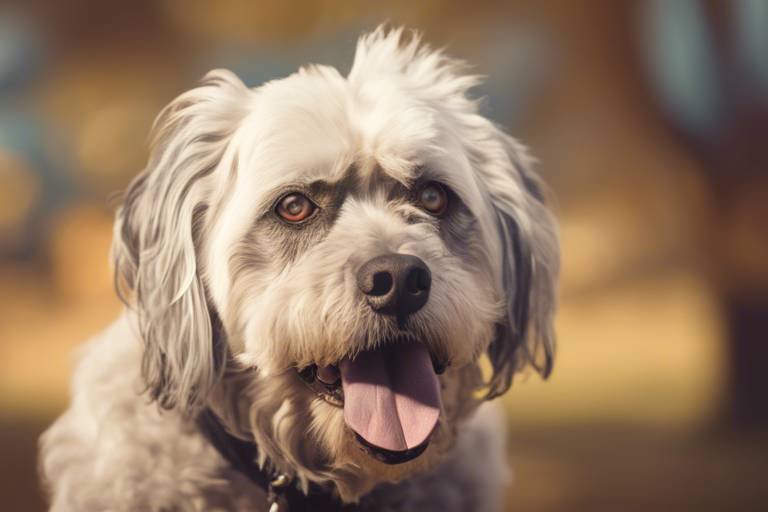Senior Pet Safety - Keeping Your Home Secure
As our furry companions age, their safety becomes a paramount concern. Senior pets, much like elderly humans, face unique challenges that require us to adapt our homes and routines to ensure their well-being. Imagine your pet as a wise old sage, navigating the world with a bit more caution and care. This article dives deep into essential tips and practices that can transform your living space into a haven for your beloved senior pets. From understanding their changing needs to identifying potential hazards, we will explore how to create a secure environment that allows them to thrive in their golden years.
As pets age, their physical and emotional needs change significantly. Senior pets often experience a decline in mobility, vision, and hearing, making it crucial for us to recognize these changes. Think of it as transitioning from a sprint to a leisurely stroll; they require more time and support to navigate their surroundings. Providing a safe and comfortable environment not only enhances their quality of life but also ensures they remain healthy and happy. Regularly observing their behavior and adapting to their needs can make a world of difference.
Many common household items can pose risks to senior pets, and it’s essential to identify and mitigate these hazards. Just as we baby-proof our homes for toddlers, we need to consider the potential dangers that can affect our older pets. Some common hazards include:
- Slippery floors that can lead to falls
- Exposed electrical cords that can be chewed on
- Small objects that can be swallowed
- Household chemicals that can be toxic
By being proactive and making simple adjustments, we can create a safe living space that protects our furry friends from potential dangers.
The type of flooring in your home can significantly impact your senior pet's mobility. Choosing non-slip surfaces and avoiding slippery materials can help prevent falls and injuries in older pets. Imagine your pet trying to walk on ice; it’s not just challenging but downright dangerous. Opt for flooring options like textured vinyl, cork, or carpet that provide better grip. If you have hardwood floors, consider adding non-slip rugs or mats in high-traffic areas.
Using rugs and mats can provide extra traction for senior pets. Selecting appropriate materials can enhance their stability and comfort, reducing the risk of accidents while they move around the house. Look for rugs with rubber backing or those specifically designed for pet safety. These small changes can significantly improve your pet's confidence and mobility.
Stairs can be particularly challenging for senior pets. Installing ramps or gates can help manage elevation changes safely, ensuring your pet can navigate your home without risk of injury. Think of the stairs as a mountain range for your furry friend; a little assistance can go a long way. If your pet struggles with stairs, consider creating a comfortable space on the main floor to eliminate the need for them to climb.
Creating designated safe spaces for senior pets to rest is essential. These areas should be comfortable, quiet, and free from hazards, allowing pets to relax and recharge without stress. Consider placing their bed in a low-traffic area where they can feel secure and undisturbed. Adding soft blankets and pillows can make their resting spot even more inviting, akin to a cozy nook just for them.
Being prepared for emergencies is crucial for senior pet safety. Having a plan in place ensures you can act quickly and effectively in case of unforeseen events, keeping your pet secure. Just like we prepare for a storm, we must have a strategy for emergencies that may arise.
A well-stocked first aid kit tailored for pets can be a lifesaver. Including essential supplies such as bandages, antiseptic wipes, and any medications your pet may need can help you respond effectively to minor injuries or health issues. Familiarizing yourself with basic pet first aid can empower you to act swiftly in emergencies.
Developing a clear evacuation plan is vital. Knowing how to safely transport your senior pet during emergencies ensures their safety and minimizes stress during potentially chaotic situations. Practice your plan regularly so that both you and your pet feel comfortable and confident when the time comes.
Maintaining proper nutrition and regular health monitoring is critical for senior pets. Understanding dietary needs and recognizing health changes can help prevent issues and promote a longer, healthier life. Just as we adjust our diets as we age, our pets require similar considerations.
As pets age, their dietary requirements often change. Adjusting their diet to meet these needs can improve their overall health and well-being, helping to manage weight and support vital organ function. Consider consulting your veterinarian for tailored dietary recommendations that cater to your pet's specific health conditions.
Frequent veterinary visits are essential for senior pets. Regular check-ups can help catch potential health issues early, allowing for timely interventions and better management of existing conditions. Think of it as a routine tune-up for a beloved old car; it keeps everything running smoothly and extends its lifespan.
1. What are the signs that my pet is entering their senior years?
Common signs include decreased energy, changes in appetite, weight fluctuations, and mobility issues. Regular vet visits can help assess these changes effectively.
2. How can I make my home more senior pet-friendly?
Focus on non-slip flooring, creating safe resting spaces, and removing potential hazards. Regularly check for any changes your pet may need to accommodate.
3. What should I include in a pet first aid kit?
Your kit should include bandages, antiseptic wipes, tweezers, and any medications your pet may require. Always consult your vet for specific recommendations.
4. How often should I take my senior pet to the vet?
It's advisable to schedule vet visits at least twice a year for senior pets to monitor their health closely.
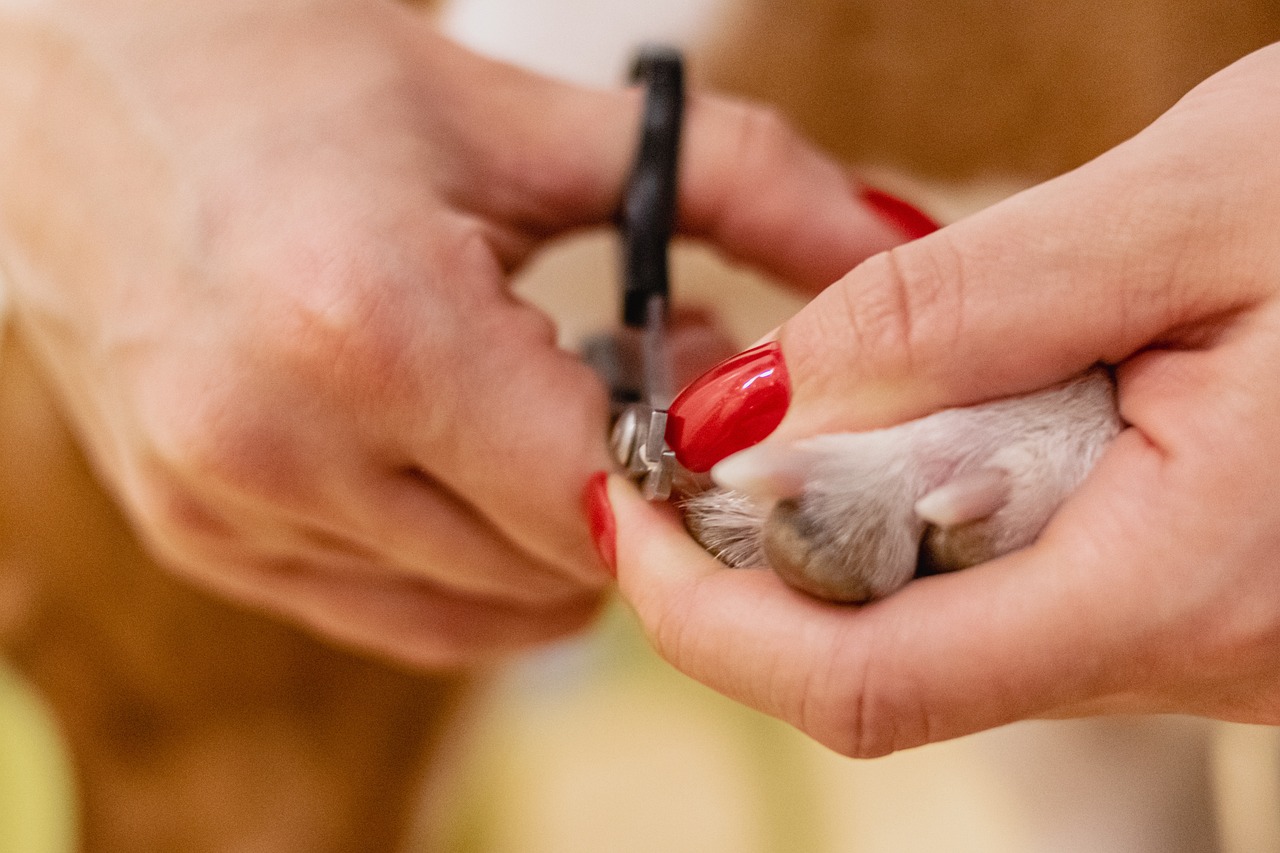
Understanding Senior Pet Needs
As pets gracefully age, their physical and emotional needs undergo significant transformations. It's like watching a beloved friend transition through different phases of life, each requiring a unique approach to care and comfort. Understanding these changes is crucial for ensuring that our senior pets feel secure, loved, and most importantly, safe in their environment. Just as we might need to adjust our lifestyle as we grow older, our furry companions need the same level of attention and adaptation.
One of the primary considerations is their mobility. Senior pets often face challenges such as arthritis or joint pain, which can make everyday activities like walking or jumping onto furniture difficult. This is why it's essential to create a living space that accommodates their needs. For instance, keeping their favorite spots easily accessible and providing ramps or steps can make a world of difference. Think of it as creating a cozy, accessible haven where they can thrive despite their limitations.
Another vital aspect is their emotional well-being. Just like humans, pets can experience anxiety, especially when faced with changes in their environment or routine. It’s important to maintain a consistent schedule for feeding, walks, and playtime. Additionally, providing a quiet, safe space where they can retreat when feeling overwhelmed can help alleviate stress. Consider it their very own sanctuary, a place where they can unwind and feel secure.
Nutrition also plays a pivotal role in the overall health of senior pets. As they age, their dietary needs may shift. Many senior pets require diets lower in calories but higher in fiber to help maintain a healthy weight and support digestion. It's akin to how our own diets evolve as we age; we need to be mindful of what fuels our bodies. Consulting with a veterinarian about the best dietary adjustments can ensure that your senior pet is receiving the nutrients they need to stay vibrant and healthy.
Lastly, regular health monitoring is essential. Senior pets are more susceptible to various health issues, and early detection can be key to effective treatment. Scheduling regular vet visits and being observant of any behavioral changes can help catch potential problems before they escalate. Think of it as a routine check-up for your best friend, ensuring they remain on the path to good health.
In summary, understanding and addressing the changing needs of senior pets is not just about keeping them safe; it's about enriching their lives in their golden years. By being proactive and attentive, you can create an environment filled with love, comfort, and security—one that allows your senior pet to thrive and enjoy their time with you.
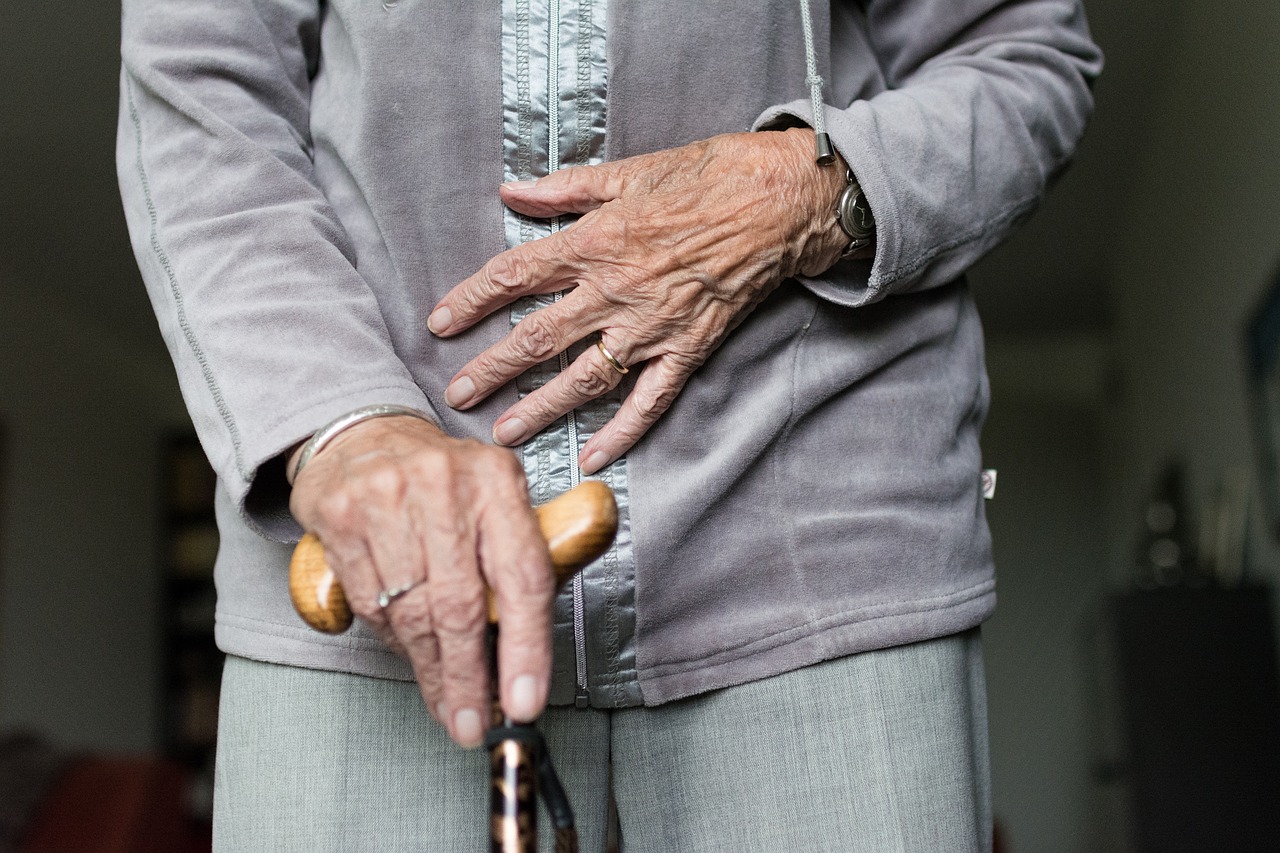
Common Household Hazards
When it comes to our beloved senior pets, the home should be a sanctuary, not a perilous landscape filled with potential threats. As our furry friends age, they may become less agile and more susceptible to accidents. This is why it’s crucial to identify and mitigate common household hazards that could jeopardize their safety. From everyday items to environmental factors, understanding these risks can make a world of difference in keeping your senior pet secure.
One of the most significant hazards lurking in our homes is the presence of toxic substances. Many household cleaners, detergents, and even certain plants can be harmful or fatal if ingested. For instance, common household plants like lilies and azaleas are known to be toxic to pets. It’s essential to keep these items out of reach or, better yet, eliminate them from your home entirely. Always check the labels of any cleaning products to ensure they are pet-safe, and consider switching to natural alternatives that won’t pose a risk.
Another common hazard is the clutter that accumulates over time. Items left on the floor, such as shoes, toys, or even cords, can become tripping hazards for senior pets, especially those with diminished vision or mobility. Regularly decluttering your living space can help create a safer environment. Additionally, consider using cord management solutions to keep electrical cords out of sight and out of reach.
Moreover, the temperature of your home can significantly affect your senior pet's comfort and safety. Older pets are often more sensitive to extreme temperatures, whether it’s the sweltering heat of summer or the biting cold of winter. Ensure your home maintains a comfortable temperature and provide cozy blankets or beds in areas where your pet likes to rest. If you notice your pet struggling to regulate their body temperature, it may be time to consult your veterinarian for advice on how to best support them.
In the kitchen, be particularly cautious. While it’s tempting to share our meals with our furry companions, many human foods can be dangerous for pets. Foods like chocolate, grapes, and onions can be toxic and should be kept well out of reach. It's crucial to educate all family members about the dangers of feeding pets table scraps and to establish a strict no-feeding policy to protect your senior pet.
Lastly, let’s not forget about the importance of proper lighting. As pets age, their eyesight may decline, making it harder for them to navigate their surroundings. Ensuring adequate lighting throughout your home, especially in areas where your pet frequently walks, can help prevent accidents. Consider using night lights in hallways or near stairs to guide your pet safely during the night.
By being proactive and aware of these common household hazards, you can create a safer, more comfortable environment for your senior pet. Remember, a little effort goes a long way in ensuring their well-being and happiness!
- What are some signs that my senior pet may be at risk of injury at home?
Watch for changes in mobility, such as difficulty getting up or navigating stairs, as well as signs of confusion or disorientation. - How can I pet-proof my home for a senior pet?
Remove clutter, secure cords, eliminate toxic plants, and ensure that food items are out of reach. - Are there specific foods I should avoid giving to my senior pet?
Yes, foods like chocolate, grapes, onions, and certain artificial sweeteners can be harmful to pets. - What should I do in case of an emergency with my senior pet?
Have a pet-specific first aid kit ready, and create an evacuation plan that includes how to transport your pet safely.
Flooring Considerations
When it comes to ensuring the safety of your senior pets, one of the most critical aspects to consider is the type of flooring in your home. As pets age, their mobility can decline, making them more susceptible to slips and falls. Imagine your furry friend trying to navigate a slippery surface—it’s like watching a toddler learn to walk for the first time! To prevent accidents, it’s essential to choose flooring materials that provide stability and support.
Opting for non-slip surfaces is a game changer. Materials like cork, rubber, or textured vinyl can significantly reduce the risk of slips. These surfaces not only help your pet maintain their balance but also offer a comfortable walking experience. On the other hand, glossy tiles or hardwood floors can be treacherous, especially for pets with arthritis or weaker joints. If you have these types of flooring, consider adding area rugs or mats to create a safer path for your pet.
Speaking of rugs, they can be a fantastic solution for enhancing traction. When selecting rugs, look for those with a non-skid backing to prevent them from sliding around. Additionally, choose materials that are easy to clean, as senior pets may have accidents more frequently. A well-placed rug can act as a safety net, providing your pet with a secure footing while they move about your home.
Another crucial factor to consider is the presence of stairs in your home. Stairs can be particularly daunting for senior pets, especially those with mobility issues. To make your home more accessible, consider installing ramps or gates to manage elevation changes safely. This way, your pet can navigate your home without the risk of injury. If ramps are not an option, ensure that stairs are well-lit and free from clutter to help your pet see where they are stepping.
In summary, the flooring in your home plays a vital role in your senior pet's safety. By choosing non-slip surfaces, utilizing rugs for added traction, and addressing any elevation challenges, you can create a pet-friendly environment that supports their mobility and overall well-being. Remember, a little adjustment can go a long way in ensuring that your beloved companion can enjoy their golden years safely and comfortably.
Rugs and Mats
When it comes to ensuring the safety and comfort of your senior pets, the choice of can make a world of difference. As our furry friends age, they may experience a decrease in balance and mobility, which can lead to slips and falls, especially on slippery surfaces. By strategically placing rugs and mats around your home, you can create a safer environment that promotes stability and confidence in your pet's movements.
When selecting rugs and mats, consider materials that offer non-slip properties. Look for options with rubber backing or those specifically designed to grip the floor. These features can significantly reduce the risk of your pet sliding as they walk or run. Additionally, the thickness of the rug can also play a role; thicker mats can provide a softer landing if your pet does stumble, helping to cushion any falls.
It's also important to think about the texture of the rugs. Soft, plush materials can be inviting for your pet to rest on, while also providing the traction they need to move about safely. However, be cautious with shaggy or overly fluffy rugs, as they can sometimes pose a tripping hazard. The goal is to strike a balance between comfort and safety.
Here are some key considerations when choosing rugs and mats for your senior pets:
- Size: Ensure the rugs are large enough to cover high-traffic areas where your pet frequently walks.
- Design: Opt for designs that complement your home decor while being functional for your pet's needs.
- Washability: Choose rugs that are easy to clean, as accidents can happen, and maintaining hygiene is crucial for your pet's health.
Incorporating rugs and mats into your home not only enhances safety but can also create a cozy atmosphere for your senior pets. Imagine your beloved companion comfortably resting on a soft mat, feeling secure and at ease. This simple addition can transform their daily experience, allowing them to navigate your home with greater confidence. Remember, the little things matter, and by making thoughtful choices about your home’s flooring, you can significantly improve your senior pet's quality of life.
Q: How do I know if my pet needs a rug or mat?
A: If your senior pet is showing signs of difficulty walking, slipping on floors, or seems hesitant to move around, it's a good indication that rugs or mats could help improve their safety and comfort.
Q: What type of rug is best for senior pets?
A: Look for rugs with non-slip backing, made from soft and durable materials. Avoid high-pile or shaggy rugs, as they can be difficult for pets to walk on.
Q: How often should I clean the rugs and mats?
A: Regular cleaning is essential, especially if your pet has accidents. Aim to wash them at least once a week, or more frequently if needed, to maintain a hygienic environment.
Stairs and Elevation Changes
This article discusses essential tips and practices to ensure the safety and well-being of senior pets in your home, highlighting potential hazards and preventive measures.
As pets age, their physical and emotional needs change. Understanding these needs is crucial for providing a safe and comfortable environment for senior pets, ensuring they remain healthy and happy.
Many common household items can pose risks to senior pets. Identifying and mitigating these hazards is vital for creating a safe living space that protects your beloved companions from potential dangers.
The type of flooring in your home can significantly impact your senior pet's mobility. Choosing non-slip surfaces and avoiding slippery materials can help prevent falls and injuries in older pets.
Using rugs and mats can provide extra traction for senior pets. Selecting appropriate materials can enhance their stability and comfort, reducing the risk of accidents while they move around the house.
Stairs can be particularly challenging for senior pets. As our furry friends age, their joints may become stiff, and their balance may waver, making elevation changes a potential hazard. It's essential to assess your home for steep stairs or sudden elevation shifts that could pose risks. Installing ramps is a great way to help your pet navigate these changes without the strain of climbing stairs. Ramps provide a gentle slope that can be easier for them to manage, reducing the likelihood of slips or falls.
Additionally, consider using gates at the top and bottom of stairs to prevent your senior pet from attempting to climb or descend without supervision. This simple precaution can save them from dangerous tumbles. If you notice your pet struggling with stairs, it might be time to rethink your home layout. You could create a cozy space on the ground floor, ensuring they have everything they need without the need to navigate stairs.
To further enhance safety, you might also want to install non-slip treads on your stairs. These can provide extra grip, making it easier for your pet to ascend and descend without fear. Remember, it’s all about making your home a haven for your senior pet, where they can feel secure and comfortable.
Being prepared for emergencies is crucial for senior pet safety. Having a plan in place ensures you can act quickly and effectively in case of unforeseen events, keeping your pet secure.
A well-stocked first aid kit tailored for pets can be a lifesaver. Including essential supplies and knowing how to use them can help you respond effectively to minor injuries or health issues.
Developing a clear evacuation plan is vital. Knowing how to safely transport your senior pet during emergencies ensures their safety and minimizes stress during potentially chaotic situations.
Maintaining proper nutrition and regular health monitoring is critical for senior pets. Understanding dietary needs and recognizing health changes can help prevent issues and promote a longer, healthier life.
As pets age, their dietary requirements often change. Adjusting their diet to meet these needs can improve their overall health and well-being, helping to manage weight and support vital organ function.
Frequent veterinary visits are essential for senior pets. Regular check-ups can help catch potential health issues early, allowing for timely interventions and better management of existing conditions.
- What are the signs that my pet is aging? Look for changes in mobility, energy levels, and eating habits. Regular vet check-ups can also help identify age-related issues.
- How can I make my home safer for my senior pet? Remove hazards, use non-slip rugs, install ramps, and ensure that their resting areas are comfortable and secure.
- What should I include in a pet first aid kit? Essential items include bandages, antiseptic wipes, tweezers, and any necessary medications prescribed by your vet.
Safe Spaces for Rest
Creating safe spaces for your senior pets to rest is not just a luxury; it's a necessity. As our furry companions age, they need a designated area where they can feel secure, comfortable, and free from the hustle and bustle of daily life. Imagine a cozy nook, perhaps by a sunny window or in a quiet corner of the living room, where your pet can curl up and snooze without a care in the world. This space should be their sanctuary, a place that feels like a warm hug after a long day.
When designing these safe spaces, consider the following factors:
- Comfort: Use soft bedding that provides adequate support for their joints. Memory foam beds or orthopedic mattresses can work wonders for older pets.
- Quietness: Ensure that the area is away from loud noises, such as the TV or bustling family activities. A peaceful environment is key to helping your pet relax.
- Accessibility: Make sure the space is easy for your pet to access. If they have mobility issues, avoid placing their bed too high or in hard-to-reach areas.
Additionally, it’s important to keep their resting area free from hazards. Check for any items that could be a tripping risk, such as loose cables or small objects that could be ingested. Regularly cleaning the area not only keeps it hygienic but also makes it more inviting for your pet.
Another aspect to consider is temperature control. Senior pets are more sensitive to extreme temperatures, so ensure their resting space is well-ventilated and protected from drafts. During colder months, a heated pet bed can provide extra warmth and comfort. Conversely, in warmer weather, ensure they have access to a cool, shaded area to prevent overheating.
Finally, remember that pets thrive on routine. Once you establish a safe space, encourage your senior pet to use it regularly. You might even consider placing their favorite toys or a piece of your clothing nearby to make the area feel even more inviting. Over time, this space will become synonymous with relaxation and safety, helping to improve their overall quality of life.
Q: How can I encourage my senior pet to use their safe space?
A: You can encourage your senior pet to use their safe space by placing their favorite toys, treats, or a piece of your clothing in the area. Additionally, you can guide them to the space during quiet times, reinforcing it as a cozy retreat.
Q: What should I do if my senior pet refuses to use their designated resting area?
A: If your pet is reluctant to use their resting area, try observing their behavior. They may prefer a different location or need more comfort in their bed. Ensure the space is quiet, comfortable, and easily accessible.
Q: How often should I clean my senior pet's resting area?
A: It's best to clean your senior pet's resting area at least once a week. Regular cleaning helps maintain hygiene and ensures that the space remains inviting and comfortable.
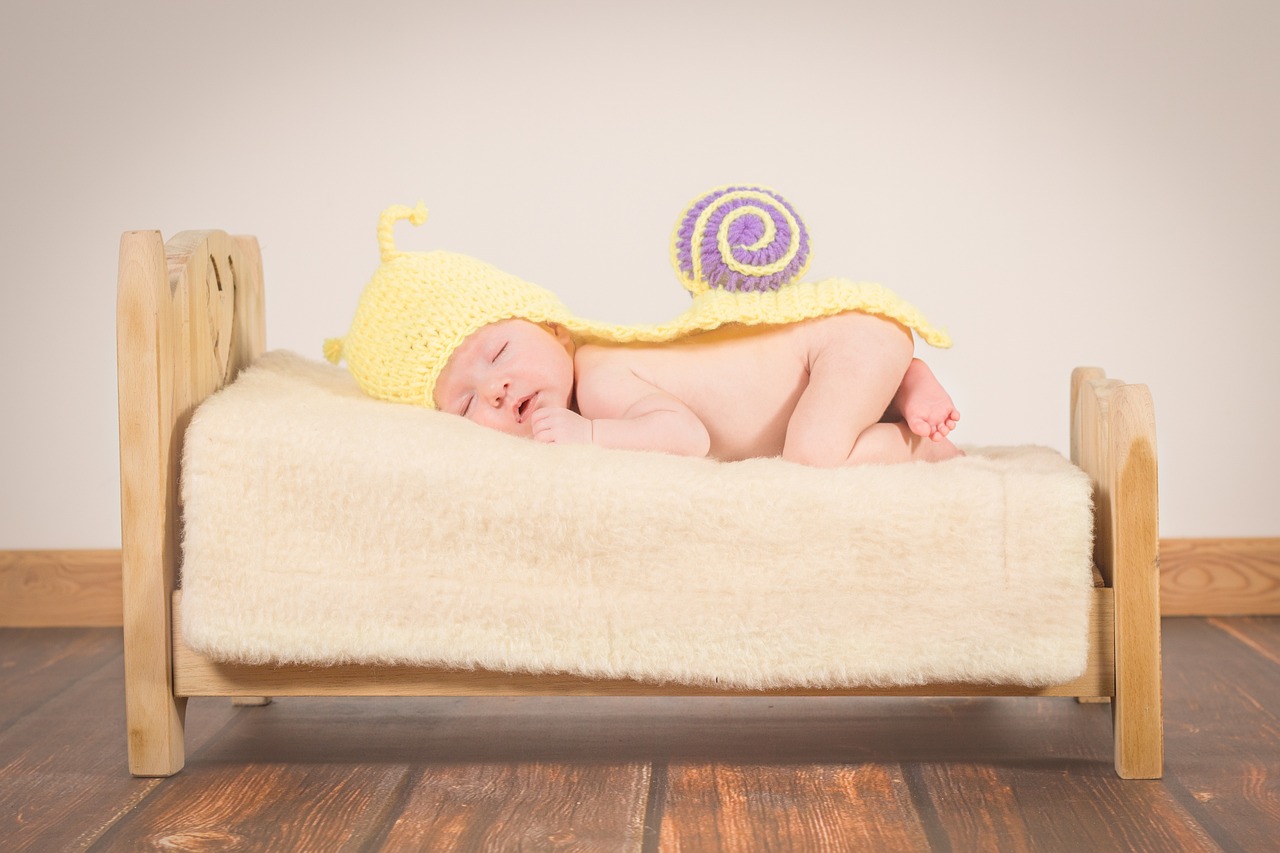
Emergency Preparedness
When it comes to keeping our beloved senior pets safe, being prepared for emergencies is not just a good idea; it’s essential. Imagine a scenario where an unexpected event occurs—a natural disaster, a sudden illness, or even a household accident. In these moments, having a solid plan can mean the difference between chaos and calm. So, how can you ensure that you and your furry friend are ready for anything? Let’s dive into some key strategies that will make emergency preparedness a breeze.
First and foremost, having a well-stocked first aid kit tailored specifically for your pet is crucial. It’s like having a safety net that you can rely on when things go awry. What should you include in this kit? Here’s a quick rundown:
- Gauze and bandages for minor injuries
- Antiseptic wipes to clean wounds
- Thermometer for checking your pet's temperature
- Emergency contact numbers, including your vet and an emergency clinic
- Medications your pet may need
Knowing how to use these supplies can empower you to respond effectively to minor injuries or health issues, ensuring your pet gets the care they need promptly.
Next up is the importance of having a clear evacuation plan. Think of this as your roadmap to safety. In the event of an emergency, knowing how to transport your senior pet safely is vital. Here are some considerations to keep in mind:
- Identify multiple evacuation routes from your home.
- Practice loading your pet into a carrier or vehicle to make it a stress-free experience.
- Have a designated safe place to go, whether it’s a friend’s house or a pet-friendly shelter.
By being proactive and preparing in advance, you can minimize stress for both you and your pet during potentially chaotic situations. It’s all about creating a sense of security and familiarity, which can be incredibly comforting for your senior companion.
Lastly, don’t forget to keep your pet’s identification up to date. Microchips and ID tags can be lifesavers if your pet gets lost during an evacuation. Regularly checking that the information is current is a small step that can have a big impact.
In summary, emergency preparedness for senior pets involves a mix of having the right supplies, planning ahead, and ensuring your pet’s identification is accurate. By taking these steps, you can create a safety net that not only protects your furry friend but also gives you peace of mind.
Q: What should I include in my pet's emergency kit?
A: Your pet's emergency kit should include basic first aid supplies, medications, food and water, a leash, and important documents like vaccination records.
Q: How can I help my senior pet during an emergency?
A: Stay calm and follow your evacuation plan. Keep your pet in a secure carrier or on a leash to prevent them from getting lost or injured.
Q: Is it necessary to have a pet-specific evacuation plan?
A: Yes! Having a pet-specific evacuation plan ensures that you can act quickly and efficiently, reducing stress for both you and your pet during emergencies.
First Aid Kits
When it comes to our beloved senior pets, being prepared for emergencies is not just a good practice; it's essential. A well-stocked first aid kit tailored specifically for pets can be a lifesaver in critical situations. Imagine your furry friend getting a minor injury or suddenly showing signs of distress. In those moments, having the right supplies at your fingertips can make all the difference. So, what should you include in your pet's first aid kit? Here’s a breakdown of essential items:
| Item | Purpose |
|---|---|
| Gauze and Bandages | To stop bleeding and protect wounds. |
| Antiseptic Wipes | To clean wounds and prevent infections. |
| Scissors | For cutting bandages or gauze. |
| Tweezers | To remove splinters or ticks. |
| Thermometer | To check for fever or other health issues. |
| Hydrogen Peroxide | To induce vomiting in case of poisoning (consult a vet first). |
| Pet First Aid Manual | Guidance on handling various emergencies. |
It’s important to not only have these items but also to know how to use them effectively. For instance, understanding how to bandage a wound or administer first aid for choking can be crucial in a tense moment. Moreover, keeping your first aid kit in a designated spot that's easily accessible can save precious time when every second counts.
Regularly check your kit to ensure that all items are in good condition and that nothing has expired. Just like a human first aid kit, your pet's kit should be refreshed periodically. And remember, while a first aid kit is invaluable, it’s not a substitute for professional veterinary care. Always consult your veterinarian for any serious health concerns.
In addition to the first aid kit, consider taking a pet first aid course. These courses can equip you with practical skills and knowledge that could prove vital in emergencies. After all, being prepared is not just about having supplies; it's about having the confidence to use them effectively.
- What should I include in my senior pet's first aid kit? Essential items include gauze, antiseptic wipes, scissors, tweezers, a thermometer, hydrogen peroxide, and a pet first aid manual.
- How often should I check my pet's first aid kit? It’s best to check your kit every few months to ensure all items are in good condition and not expired.
- Can I use human first aid supplies on my pet? While many supplies overlap, always consult your veterinarian before using human products on pets, as some can be harmful.
Evacuation Plans
When it comes to keeping your senior pet safe, having a solid evacuation plan is non-negotiable. Imagine the chaos of an emergency situation—fires, floods, or natural disasters can strike without warning, and the last thing you want is to be scrambling to figure out how to get your furry friend to safety. So, what should you do to prepare? First, think about your home layout and identify the quickest exits. This means knowing where the nearest doors and windows are, and how to access them without hesitation.
Next, it's essential to have a designated spot for your pet's essentials. This includes their leash, collar, and any medications they might need. Keeping these items in a readily accessible location can save precious time when every second counts. You might even consider a portable pet carrier that’s easy to grab and transport. After all, who wants to be fumbling around for a leash while the clock is ticking?
Additionally, practice makes perfect. Just like you would rehearse a fire drill with your family, take some time to walk through your evacuation plan with your pet. This not only familiarizes your pet with the process but also helps you gauge how they might react in a real emergency. If your senior pet is anxious or has mobility issues, consider how you might need to assist them. For instance, you might need to carry smaller pets or help larger ones navigate stairs.
It's also wise to have a list of pet-friendly shelters or hotels in your area. In the event that you need to evacuate your home, knowing where you can stay with your pet can alleviate a lot of stress. You don’t want to be left scrambling for a place that accommodates your beloved companion. To make things easier, you could create a simple table that outlines local resources:
| Location | Contact Number | Pet Policy |
|---|---|---|
| Local Pet-Friendly Shelter | (555) 123-4567 | Allowed with proof of vaccination |
| Nearby Hotel | (555) 987-6543 | Pet-friendly, additional fee applies |
| Friend or Family Member | N/A | Pet allowed, confirm in advance |
Finally, don’t forget to keep your pet’s identification up to date. Microchips and tags with your contact information are crucial. In the chaos of an evacuation, pets can easily become disoriented and lost, so having a reliable way to reunite is essential. Remember, an ounce of prevention is worth a pound of cure, especially when it comes to your senior pet's safety.
In conclusion, an effective evacuation plan is about more than just knowing how to get out of your house; it's about ensuring your senior pet feels safe and secure during a potentially frightening time. By preparing in advance and thinking through the details, you can make a world of difference for your furry friend when it matters most.
- What should I include in my pet's emergency kit? Include food, water, medications, a leash, and any comfort items like toys or blankets.
- How can I help my senior pet feel more comfortable during an evacuation? Familiarize them with their carrier or safe space, and keep their favorite items close.
- Are there special considerations for evacuating with senior pets? Yes, consider their mobility and health needs, and plan to assist them if necessary.
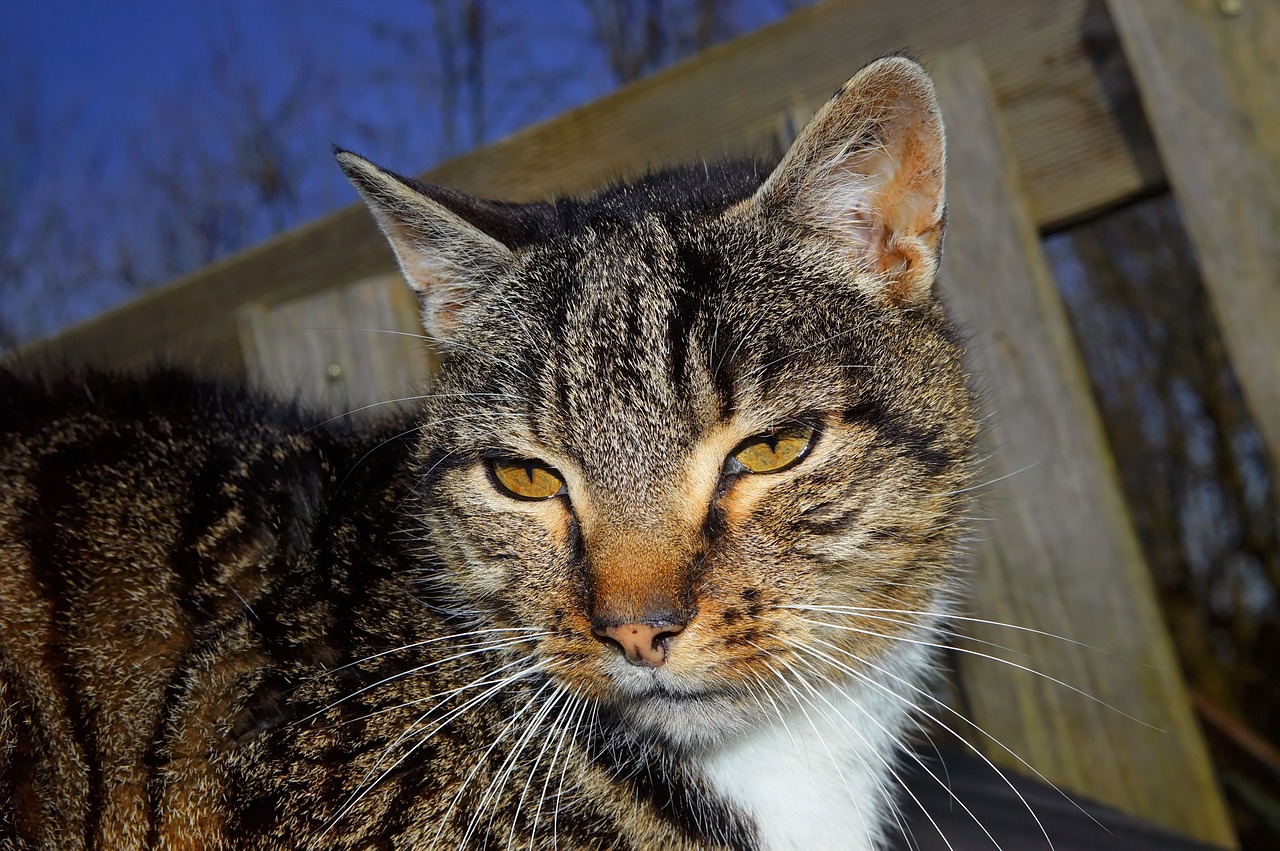
Nutrition and Health Monitoring
Maintaining proper nutrition and regular health monitoring is critical for senior pets. As our furry friends age, their bodies undergo numerous changes that can affect their nutritional needs and overall health. It's like watching a beloved old car; it may still run, but it requires different care to keep it in top shape. Understanding these dietary shifts is essential to ensure your pet continues to thrive in their golden years.
One of the first steps in this journey is to adjust your pet's diet. Senior pets often require fewer calories but more nutrient-dense foods. This is crucial to prevent obesity, which can lead to a host of health issues such as diabetes and joint problems. Look for high-quality senior pet food that contains essential nutrients like omega fatty acids for a shiny coat, glucosamine for joint health, and fiber for digestive support. If you're unsure, consult your veterinarian for personalized recommendations. They can help you craft a diet plan that aligns with your pet's specific health needs.
Regular vet check-ups are another vital aspect of health monitoring. These visits serve as a preventive measure, allowing for early detection of potential health issues. Think of it as a routine tune-up for your car; catching problems early can save you from costly repairs later. During these check-ups, your vet will assess your pet's weight, dental health, and overall condition. They may also recommend blood tests to monitor organ function and check for underlying conditions that might not be immediately visible.
In addition to regular vet visits, it's essential to keep an eye on your pet's behavior and habits at home. Changes in appetite, energy levels, or bathroom habits can be indicators of health issues. For instance, if your senior dog suddenly becomes less active or shows reluctance to eat, it might be time for a vet visit. Being vigilant can make all the difference in ensuring your pet remains happy and healthy.
Lastly, consider keeping a health journal for your senior pet. Documenting their diet, behavior changes, and vet visits can provide valuable insights over time. This journal acts as a roadmap for both you and your veterinarian, helping to track any changes and adjust care as needed. Remember, a little proactive care goes a long way in ensuring your furry friend enjoys their golden years to the fullest!
- What should I feed my senior pet? Senior pets typically require a diet lower in calories but higher in essential nutrients. Look for food specifically formulated for senior pets.
- How often should I take my senior pet to the vet? Regular check-ups are recommended at least once or twice a year, but consult your veterinarian for a schedule tailored to your pet's health needs.
- What signs should I watch for in my senior pet? Look for changes in appetite, energy levels, or behavior. Any sudden shifts could indicate health issues and should be discussed with your vet.
Dietary Adjustments
As our furry friends grow older, their bodies undergo a multitude of changes that can significantly impact their nutritional requirements. Just like humans, senior pets experience shifts in metabolism, activity levels, and overall health, which means that their diets need to be adjusted accordingly. Ignoring these changes can lead to a range of health issues, from obesity to malnutrition. So, how can you ensure that your senior pet is getting the right nutrition? Let’s dive into some essential dietary adjustments that will keep your beloved companion healthy and happy.
First and foremost, it’s important to consult your veterinarian when making dietary changes. They can provide tailored advice based on your pet’s specific health needs, weight, and activity level. A well-balanced diet for senior pets typically includes a mix of high-quality proteins, healthy fats, and essential vitamins and minerals. For example, you might consider incorporating more easily digestible proteins, such as chicken or fish, while reducing carbohydrates that can lead to weight gain.
Furthermore, hydration is another critical aspect of a senior pet's diet. Older pets may not drink enough water, which can lead to dehydration and kidney issues. To encourage hydration, consider offering wet food options or adding water or broth to dry kibble. This not only enhances flavor but also increases moisture intake. Moreover, be on the lookout for any signs of changes in appetite or drinking habits, as these could indicate underlying health problems.
Another key factor to consider is weight management. Many senior pets become less active, which can lead to weight gain if their food intake remains the same. Monitoring your pet’s weight and adjusting their portions accordingly is crucial. You might also want to explore specialized senior pet foods that are formulated to support weight management, joint health, and overall vitality. Here’s a quick overview of some dietary adjustments to consider:
| Dietary Component | Adjustment | Benefits |
|---|---|---|
| Protein | Increase high-quality, easily digestible proteins | Supports muscle mass and overall health |
| Carbohydrates | Reduce simple carbohydrates | Helps manage weight and energy levels |
| Fats | Incorporate healthy fats | Supports skin, coat health, and energy |
| Hydration | Increase moisture content in food | Promotes hydration and kidney health |
Lastly, don’t forget about the importance of supplements. Depending on your pet's health conditions, your veterinarian may recommend supplements such as glucosamine for joint health, omega fatty acids for skin and coat, or antioxidants to support overall wellness. These can be vital in helping your senior pet maintain their quality of life.
In summary, dietary adjustments for senior pets are not just about changing their food; it’s about understanding their unique needs and ensuring they receive the best nutrition possible. By staying vigilant and proactive, you can help your furry companion thrive in their golden years.
- What should I look for in senior pet food? Look for high-quality proteins, fewer carbohydrates, and added nutrients like omega fatty acids and antioxidants.
- How often should I feed my senior pet? It’s often beneficial to feed smaller, more frequent meals to help with digestion and maintain energy levels.
- Can I give my senior pet human food? Some human foods are safe, but always consult your vet first. Foods like cooked chicken or carrots can be healthy treats.
- How can I tell if my senior pet is overweight? You should be able to feel their ribs without too much pressure. If you can’t, they may need a dietary adjustment.
Regular Vet Check-ups
This article discusses essential tips and practices to ensure the safety and well-being of senior pets in your home, highlighting potential hazards and preventive measures.
As pets age, their physical and emotional needs change. Understanding these needs is crucial for providing a safe and comfortable environment for senior pets, ensuring they remain healthy and happy.
Many common household items can pose risks to senior pets. Identifying and mitigating these hazards is vital for creating a safe living space that protects your beloved companions from potential dangers.
The type of flooring in your home can significantly impact your senior pet's mobility. Choosing non-slip surfaces and avoiding slippery materials can help prevent falls and injuries in older pets.
Using rugs and mats can provide extra traction for senior pets. Selecting appropriate materials can enhance their stability and comfort, reducing the risk of accidents while they move around the house.
Stairs can be particularly challenging for senior pets. Installing ramps or gates can help manage elevation changes safely, ensuring your pet can navigate your home without risk of injury.
Creating designated safe spaces for senior pets to rest is essential. These areas should be comfortable, quiet, and free from hazards, allowing pets to relax and recharge without stress.
Being prepared for emergencies is crucial for senior pet safety. Having a plan in place ensures you can act quickly and effectively in case of unforeseen events, keeping your pet secure.
A well-stocked first aid kit tailored for pets can be a lifesaver. Including essential supplies and knowing how to use them can help you respond effectively to minor injuries or health issues.
Developing a clear evacuation plan is vital. Knowing how to safely transport your senior pet during emergencies ensures their safety and minimizes stress during potentially chaotic situations.
Maintaining proper nutrition and regular health monitoring is critical for senior pets. Understanding dietary needs and recognizing health changes can help prevent issues and promote a longer, healthier life.
As pets age, their dietary requirements often change. Adjusting their diet to meet these needs can improve their overall health and well-being, helping to manage weight and support vital organ function.
Regular veterinary check-ups are a cornerstone of senior pet care. These visits are not just routine; they are an opportunity to catch potential health issues before they escalate. Think of it like a regular tune-up for your car—without it, small problems can turn into major repairs. Senior pets are particularly vulnerable to a range of health issues, including arthritis, diabetes, and heart disease. During these check-ups, your vet will perform a thorough examination that includes:
- Weight assessment
- Blood tests to check organ function
- Dental examinations
- Joint and mobility evaluations
By keeping a close eye on your pet's health through regular visits, you can detect changes early, allowing for timely interventions that can make all the difference in their quality of life. Additionally, discussing any behavioral changes or concerns with your vet during these appointments can provide insights into your pet's well-being. Regular check-ups can also help you stay informed about vaccinations and preventive care, ensuring your senior pet remains protected against diseases.
1. How often should I take my senior pet to the vet?
It's generally recommended to schedule veterinary check-ups at least twice a year for senior pets. However, if your pet has existing health issues, more frequent visits may be necessary.
2. What signs should I look for that indicate my senior pet needs to see a vet?
Look for changes in behavior, appetite, weight, energy levels, or mobility. Any unusual symptoms should prompt a vet visit.
3. Are there specific vaccinations my senior pet needs?
Yes, senior pets may require different vaccinations compared to younger pets. Consult your veterinarian to determine the appropriate vaccination schedule.
4. Can I manage my senior pet's health at home?
While you can monitor your pet's behavior and diet at home, regular vet check-ups are essential for professional assessments and interventions.
Frequently Asked Questions
- What are the most common hazards for senior pets at home?
Senior pets face various hazards, including slippery floors, stairs, toxic plants, and small objects that can be easily ingested. It's crucial to identify these risks and take steps to mitigate them, ensuring a safe environment for your furry friend.
- How can I make my home safer for my senior pet?
To enhance safety, consider installing non-slip flooring, using rugs for traction, and creating safe spaces for rest. Additionally, removing hazardous items, such as toxic plants and small choking hazards, will help keep your senior pet secure.
- What should I include in a pet first aid kit?
A well-stocked pet first aid kit should include items like gauze, bandages, antiseptic wipes, tweezers, and a digital thermometer. It's also beneficial to have a list of emergency contacts, including your veterinarian and a nearby animal hospital.
- How often should I take my senior pet to the vet?
Senior pets should ideally visit the veterinarian at least twice a year. Regular check-ups help catch potential health issues early and ensure that any necessary dietary or lifestyle changes are made to support their health.
- Are there specific dietary needs for senior pets?
Yes, as pets age, their dietary requirements change. Senior pets may need diets lower in calories but higher in fiber, along with specific nutrients to support joint health and organ function. Always consult your vet for personalized dietary recommendations.
- What are the signs that my senior pet may need immediate veterinary attention?
Look for signs such as sudden weight loss, difficulty breathing, excessive vomiting or diarrhea, lethargy, or changes in behavior. If you notice any of these symptoms, it’s essential to contact your veterinarian right away.
- How can I help my senior pet navigate stairs safely?
To assist your senior pet with stairs, consider installing ramps or gates to prevent falls. You can also train them to use the stairs slowly and carefully, providing support as needed. Avoid letting them navigate stairs unsupervised.
- What kind of bedding is best for senior pets?
Choose bedding that offers good support and comfort, such as orthopedic beds. These beds can help alleviate pressure on joints and provide a cozy place for your senior pet to rest and recover.


